|
The Gateway Arch is the nation's tallest monument (630 feet tall). It is 75 feet taller than the Washington Monument and over twice as tall as the Statue of Liberty.
In 1935 the old St. Louis Riverfront was selected as the site of the Jefferson National Memorial, which commemorates the Westward Expansion of the United States in the 19th century, as envisioned by Thomas Jefferson.
|
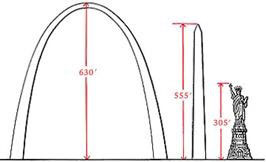
Courtesy of the National Park Service.
|
|
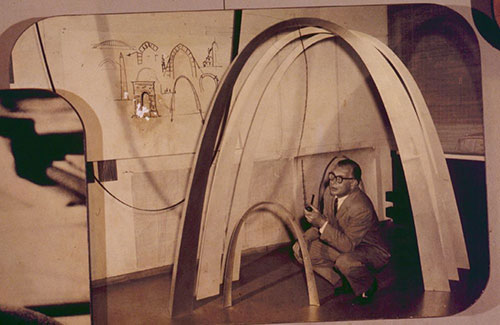
Eero Saarinen kneeling beneath a model of the Gateway Arch. Courtesy of the National Park Service.
|
The Memorial includes an underground visitor's center directly underneath the Arch. The center contains the Museum of Westward Expansion, which tells the century-long story of the opening of the West in the 1800s through films shown in several movie theaters.
The Gateway Arch was designed by a renowned architect, Eero Saarinen.
Learn more about Eero Saarinen
|
Construction
|
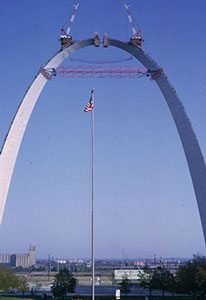
View of the Gateway Arch under construction almost completed. Courtesy of the National Park Service.
|
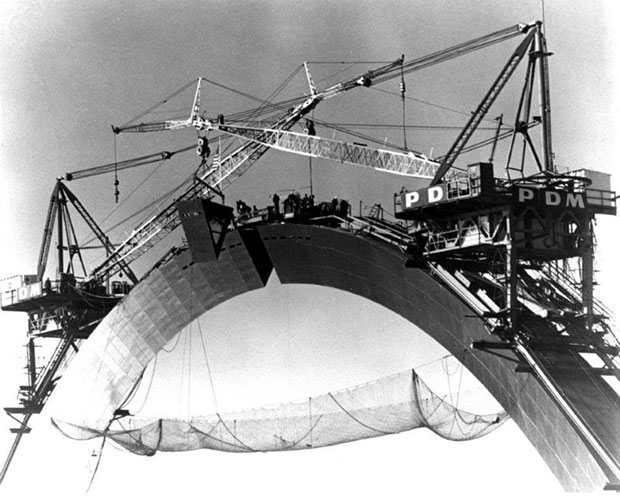
Arch under construction. Courtesy of the National Park Service.
|
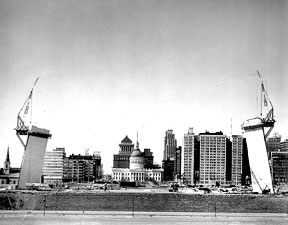
The image on this page is an animated image of the construction of the Gateway Arch between February 29, 1964 - October 28, 1965. There are nine images in this animation that show the Arch at different points during its construction. Courtesy of the National Park Service.
|
The Jefferson National Expansion Memorial Association, a group of public citizens, held a nationwide competition in 1947 to obtain a suitable design. The winning design was won by architect Eero Saarinen, it would be the start of his career.
|
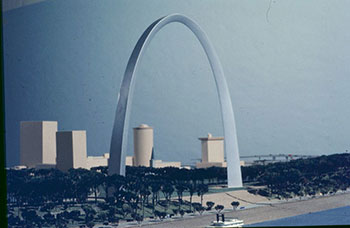
View of Eero Saarinen model of St Louis Gateway Arch and riverfront. Courtesy of the National Park Service.
|
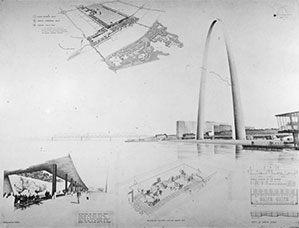
Presentation collage entry #144 by Eero Saarinen. Courtesy of the National Park Service.
|
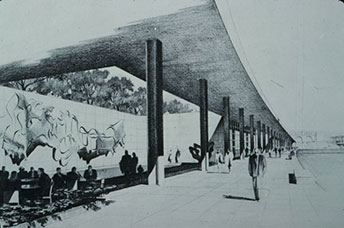
Detail, entry #144 by Eero Saarinen. Courtesy of the National Park Service.
|
The glorious concept, imposing in its setting and unique in its design, the Gateway Arch was part of the $30 million Jefferson National Expansion Memorial. It also serves as one of three firsts in the history of engineering in this country, all in the City of St. Louis.
Historic bridges surround the north and south of The Arch, to the north you have Eads Bridge was the first tubular steel arch structure of its kind. At the southern end of Poplar Street Bridge which is a steel plate girder bridge the first U.S. Bridge of this size to employ orthotropic design. The Gateway Arch borrows the arch concept from Captain Eads and makes use of the new concept of stress analysis and structural design from Poplar Street Bridge.
Eero Saarinen conceived the Arch in stainless steel and asked structural engineer Fred Severud to study its feasibility from the structural engineering point of view, demonstrating the need for joining the skills of more than one discipline in order to create a project of this magnitude.
|
The stainless-steel-faced Arch spans 630 feet between the outer faces of its triangular legs at the ground level, and its top soars 630 feet into the sky. It takes the shape of an inverted catenary curve; a shape such as would be formed by a heavy chain hanging freely between two supports.
Each leg is a symmetrical triangle with sides 54 feet long at ground level, narrowing to 17 feet at the top. The legs have double walls of steel 3 feet apart at ground level and 7-3/4 inches apart above the 400-foot level. Up to the 300-foot mark, the space between the walls is filled with reinforced concrete. Beyond that point, steel stiffeners are used.
|
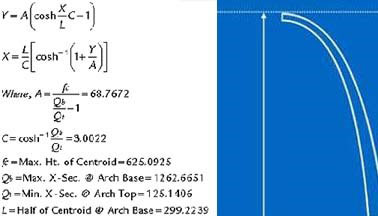
The how to achieve a catenary curve. Courtesy of the National Park Service.
|
The double-walled, triangular sections were placed one on top of another and then welded inside and out to build the legs of the Arch. Sections ranged in height from 12 feet at the base to 8 feet for the two keystone sections. The amazing part is The Arch has no real structural skeleton. Its inner and outer steel skins, joined to form a composite structure, give it its strength and permanence.
Entrance to the Arch is through the soon to be newly completed museum to the George B. Hartzog, Jr. Visitor Center, located directly beneath it. Visitors will ride a unique conveyance a 40-passenger train made up of eight five-passenger capsules in each leg to the observation platform at the top of the Arch. The capsules move at a rate of 340 feet per min., the ride takes 10 minutes round trip. The observation platform is 65 feet by 7 feet, with plate-glass windows providing views to the east and west of The Arch.
The Significance of the Arch Grounds
|
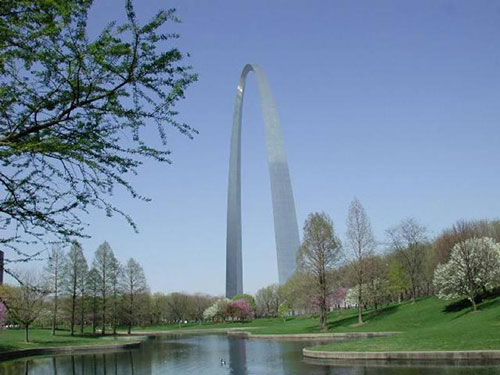
Courtesy of the National Park Service.
|
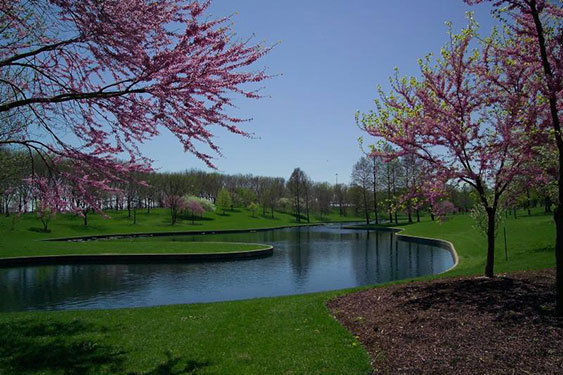
Gateway Arch Grounds in spring. Courtesy of the National Park Service.
|
The Gateway Arch and its surrounding grounds were designated a National Historic Landmark in 1987. The Arch was only 24 years old when NHL designation was bestowed and the landscape plan had been completed only seven years earlier.
The Arch’s landscape reflects the nature of the structure. Landscape design was applied by landscaping architect Dan Kiley. He applied geometrical precepts and classical design elements to create a setting that is both stunningly and subtly appropriate. The landscaping brings The Arch and its grounds to a comprehensive work melding landscape and sculpture.
|
The physical components that establish the importance of the landscape are:
- The spatial organization, which includes the axial relationship between the Arch and the Old Courthouse; the contrast between the open space beneath the Arch and the enclosed canopy of trees along the north-south walkways; and the scattering of canopy trees over the open lawn around the ponds.
- The topography, which is level under the arch, and slopes down in undulating waves to the ponds, and then ramps back up to the berm along the edge of Memorial Drive. Saarinen’s design recessed the expressway to minimize the noise and the physical and visual intrusion that would be imposed by an at-grade highway.
|
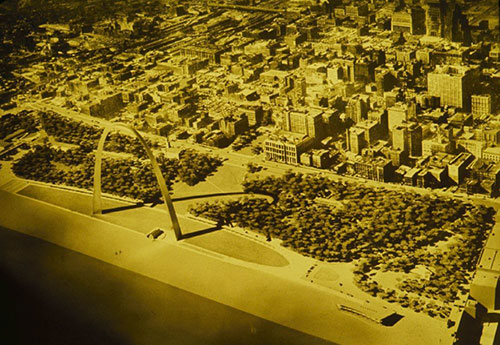
Presentation model entry 144 by Eero Saarinen. Courtesy of the National Park Service.
|
- The specific buildings and structures specified by Saarinen, including the Gateway Arch, the Old Courthouse, the underground Museum, the North and South Overlooks, and the North and South Railroad tunnels.
- The vegetation, including the Rosehill Ash monoculture that defines the walks leading to the Arch; the Bald Cypress circles; the plantings around the North and South ponds; and the trees and shrubs planted around the service areas.
- Views connecting the Arch and the Old Courthouse and leading along the north-south axis up to the Arch; views to the Arch from the ponds; and views to the Arch from East St. Louis.
- Circulation networks, such as the parking garage, sidewalks leading to the Arch and connecting the Arch to the city; and the Grand Staircase.
- Water features—the north and south ponds.
- Site furnishings—the benches and light standards.
Museum of Westward Expansion Exhibits:
St. Louis: Early St. Louis (1764-1804)
The establishment of St. Louis by Pierre Laclede and Auguste Chouteau in 1764 and the French culture and their American Indian trading partners. The interior of a French colonial house and some of the tools used by the French settlers of the growing river town are featured.
St. Louis: Exploring the West (1804-1840)
The story of the Lewis and Clark expedition, the American period of the fur trade and mountain-men which nearly caused the extinction of the beaver.
St. Louis: Clash of Cultures (1840-1890)
Chronicles the way of life of the Plains Indian tribes, the pioneer movement and settlement of the far west, and the treatment of American Indians from the reservation era to today.
|
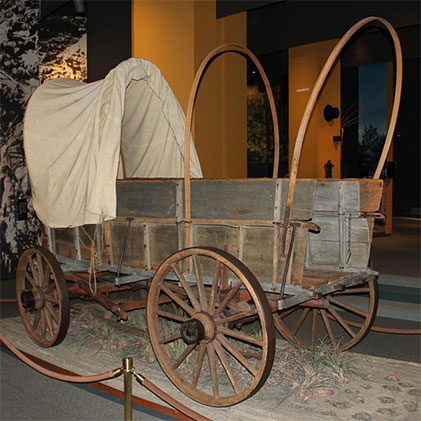
Overland Wagon in the Museum of Westward Expansion. Courtesy of the National Park Service.
|
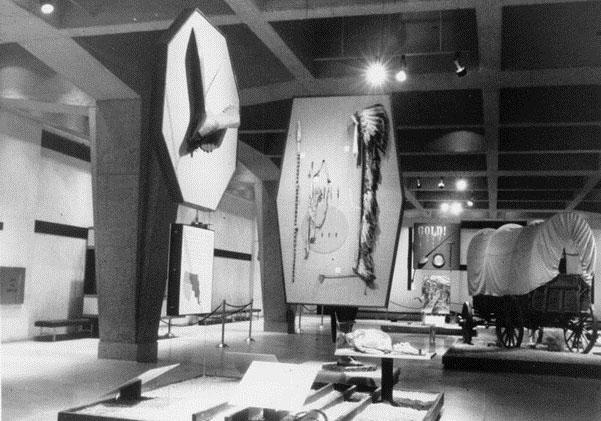
Interim exhibit before the opening of the Museum of Westward Expansion in 1976. Courtesy of the National Park Service.
|